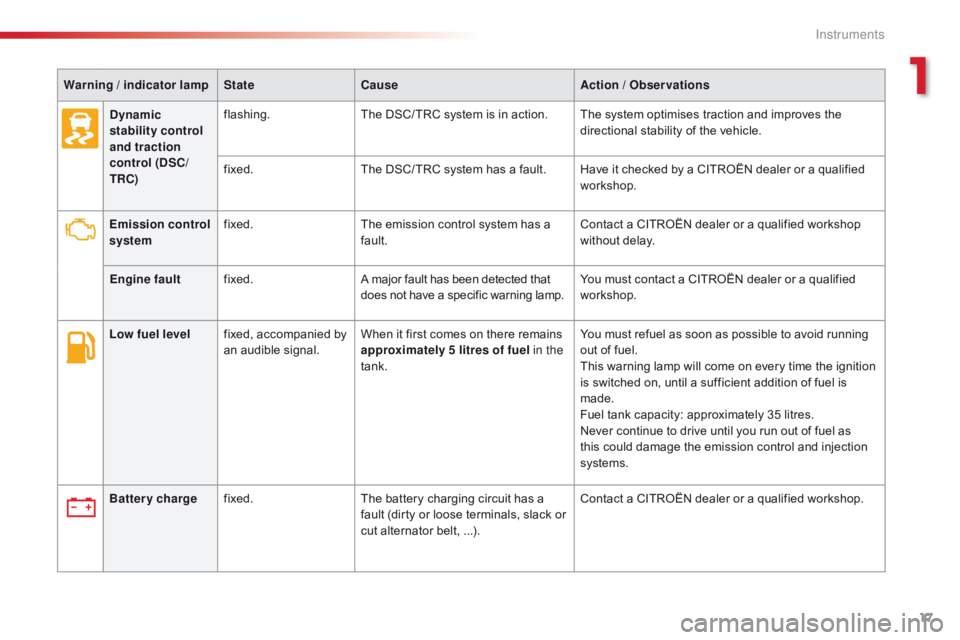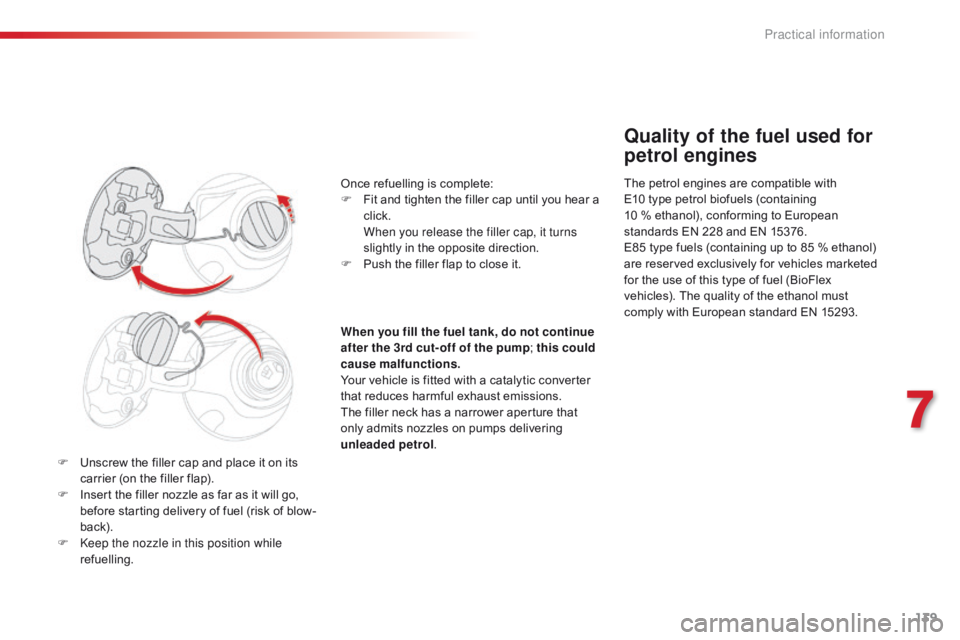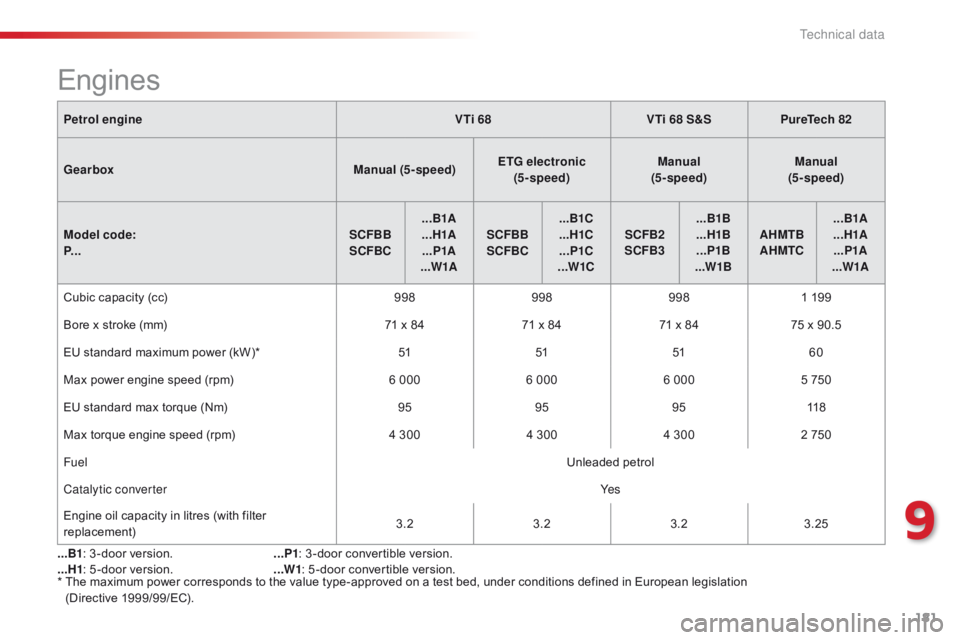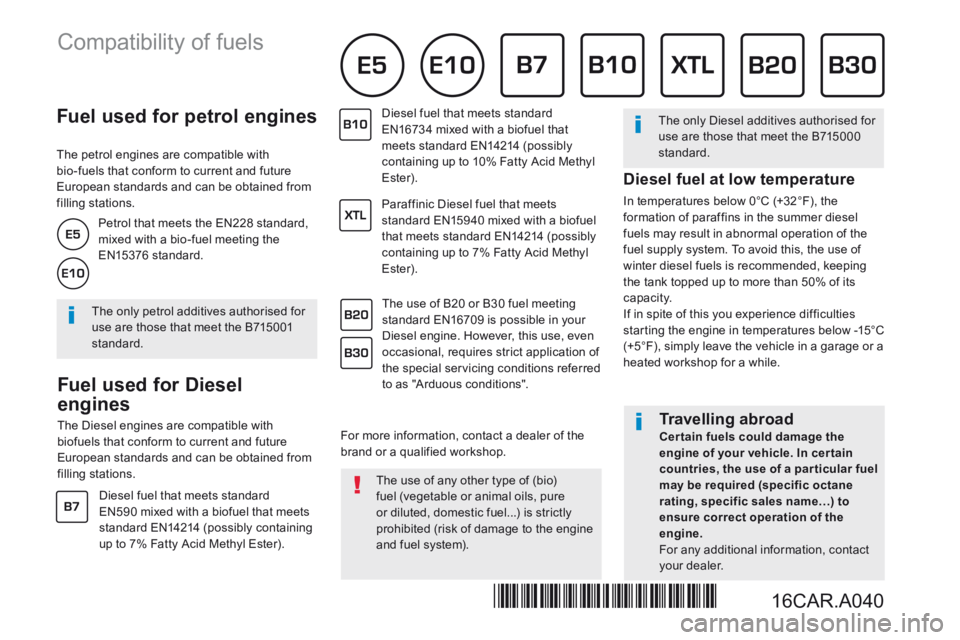fuel cap CITROEN C1 2021 Owners Manual
[x] Cancel search | Manufacturer: CITROEN, Model Year: 2021, Model line: C1, Model: CITROEN C1 2021Pages: 269, PDF Size: 7.63 MB
Page 19 of 269

17
C1_en_Chap01_instrument- de-bord_ed01-2016
Low fuel levelfixed,  accompanied  by  a
n  audible  signal.When
 it  first  comes  on  there  remains  a
pproximately 5 litres of fuel in the
tank. You
 must  refuel  as  soon  as  possible  to  avoid  running  o
ut  of  fuel.
This
 warning  lamp  will  come  on  every  time  the  ignition Â
i
s  switched  on,  until  a  sufficient  addition  of  fuel  is Â
m
ade.
Fuel
 tank  capacity:  approximately  35  litres.
Never
 continue  to  drive  until  you  run  out  of  fuel  as Â
t
his  could  damage  the  emission  control  and  injection Â
s
ystems.
Battery charge fixed. The
 battery  charging  circuit  has  a Â
f
ault  (dirty  or  loose  terminals,  slack  or Â
c
ut  alternator  belt,  ...).Contact
 a  CITROËN  dealer  or  a  qualified  workshop.
Emission control
system
fixed.
The  emission  control  system  has  a Â
f
ault.
Contact  a  CITROĂ‹N  dealer  or  a  qualified  workshop Â
w
ithout  delay.
Engine fault fixed. A  major  fault  has  been  detected  that
 d
oes  not  have  a  specific  warning  lamp.
You  must  contact  a  CITROĂ‹N  dealer  or  a  qualified Â
w
orkshop.
Dynamic
stability control
and traction
control (DSC/
TRC)
flashing.
The  DSC/ TRC  system  is  in  action. The  system  optimises  traction  and  improves  the Â
d
irectional  stability  of  the  vehicle.
fixed. The  DSC/ TRC  system  has  a  fault. Have  it  checked  by  a  CITROĂ‹N  dealer  or  a  qualified Â
w
orkshop.
Warning
/ indicator lamp
State Cause Action
/ Observations
1
Instruments
Page 140 of 269

138
C1_en_Chap07_info-pratiques_ed01-2016
Fuel tank
Low fuel levelRefuelling
When the low fuel level is reached, t
his  warning  lamp  comes  on, Â
a
ccompanied  by  an  audible  signal.
The
Â
message  "LO  FUEL"  is  displayed  in  place Â
o
f
Â
the
Â
range.
You have approximately 5 litres remaining.
In
Â
certain
 driving  conditions  and  depending  on Â
t
he
Â
engine,  the  distance  which  can  be  travelled Â
w
ith
Â
the
Â
fuel  remaining  may  be  less  than Â
3
0Â miles
Â
(50 Â km). To
 refuel  in  complete  safety:
F
Y
ou must stop the engine and switch off
the ignition (ignition in "LOCK" position
or "OFF" mode) .
F
Â
P
ull  the  control  on  the  lower  dashboard, Â
d
river's  side,  to  release  the  filler  flap.
F
Â
O
pen  the  fuel  filler  flap.
If
Â
you  run  out  of  fuel,  the  emission Â
c
ontrol  system  warning  lamp  may  come Â
o
n
Â
in  the  instrument  panel.  It  will  go  off Â
a
utomatically  after  the  engine  has  been Â
s
tarted  a  few  times. Refuelling
 must  only  be  done  with the engine
stopped and the ignition switched off ( ignition s
witch in the "LOCK" position or " OFF"
 mode).
The capacity of the fuel tank is approximately 35 litres.
Additions of  fuel  must  be  of  at  least  5  litres  to Â
b
e  registered  by  the  fuel  gauge.
A
 label  on  the  inside  of  the  flap  reminds  you Â
w
hich  type  of  fuel  to  use.
There
 may  be  an  inrush  of  air  when  removing Â
t
he  filler  cap.  This  vacuum  is  per fectly  normal Â
a
nd  results  from  the  sealing  of  the  fuel  system.
Practical information
Page 141 of 269

139
C1_en_Chap07_info-pratiques_ed01-2016
F Unscrew the  filler  cap  and  place  it  on  its  c
arrier  (on  the  filler  flap).
F
Â
I
nsert  the  filler  nozzle  as  far  as  it  will  go, Â
b
efore  starting  delivery  of  fuel  (risk  of  blow-
back).
F
K
eep the nozzle in this position while
refuelling.
Quality of the fuel used for
petrol engines
The petrol engines are compatible withÂ
E 10  type  petrol  biofuels  (containing Â
10
 %  ethanol),  conforming  to  European Â
s
tandards  EN  228  and  EN  15376.
E85
 type  fuels  (containing  up  to  85  %  ethanol) Â
a
re  reserved  exclusively  for  vehicles  marketed Â
f
or  the  use  of  this  type  of  fuel  (BioFlex Â
v
ehicles).  The  quality  of  the  ethanol  must Â
c
omply  with  European  standard  EN  15293.
Once
Â
refuelling
Â
is
Â
complete:
F
Â
F
it
Â
and
Â
tighten
Â
the
Â
filler
Â
cap
Â
until
Â
you
Â
hear
Â
a
Â
c
lick.
W
hen you release the filler cap, it turns
slightly
Â
in
Â
the
Â
opposite
Â
direction.
F
Â
P
ush
Â
the
Â
filler
Â
flap
Â
to
Â
close
Â
it.
When you fill the fuel tank, do not continue
after the 3rd cut- off of the pump ;
Â
this could
cause malfunctions .
Your
Â
vehicle
Â
is
Â
fitted
Â
with
Â
a
Â
catalytic
Â
converter
Â
t
hat
Â
reduces
Â
harmful
Â
exhaust
Â
emissions.
The
Â
filler
Â
neck
Â
has
Â
a
Â
narrower
Â
aperture
Â
that
Â
o
nly
Â
admits
Â
nozzles
Â
on
Â
pumps
Â
delivering
Â
unl
eaded petrol .
7
Practical information
Page 183 of 269

181
C1_en_Chap09_caracteristiques-techniques_ed01-2016
Petrol engineVTi 68VTi 68 S&SPureTech 82
Gearbox Manual (5 - speed) ETG electronic
(5 - speed) Manual
(5 - speed) Manual
(5 - speed)
Model code:
P... SCFBB
SCFBC ...B1A
...H1A ...P1A
...W1A SCFBB
SCFBC ...B1C
...H1C ...P1C
...W1C SCFB2
SCFB3 ...B1B
...H1B ...P1B
...W1B AHMTB
AHMTC ...B1A
...H1A ...P1A
...W1A
Cubic
 capacity  (cc) 9989989981
 199
Bore
 x  stroke  (mm) 71
 x  8471
 x  8471
 x  8475
 x  90.5
EU
 standard  maximum  power  (kW)* 51515160
Max
 power  engine  speed  (rpm) 6
 0006
 0006
 0005
 750
EU
 standard  max  torque  (Nm) 959595118
Max
 torque  engine  speed  (rpm) 4
 3004
 3004
 3002
 750
Fuel Unleaded
 p
etrol
Catalytic converter Ye s
Engine
 oil  capacity  in  litres  (with  filter Â
r
eplacement) 3.2
3.23.23.25
*
 Â
T
he  maximum  power  corresponds  to  the  value  type-approved  on  a  test  bed,  under  conditions  defined  in  European  legislation Â
(Directive
 1
999/99/EC).
Engines
...B1:  3 -door  version.
...H1 :
 5 -door  version. ...P1
:  3 -door  convertible  version.
...W1 :
 5 -door  convertible  version.
9
Technical data
Page 257 of 269

255
C1_en_Chap11_index-alpha_ed01-2016
ABS .......................................................107, 10 8
Accessories .............................. ....................142
Access
 to  rear  seats  (3 -door) Â
.........................47
A
ctive  City  Brake Â
........................................... 11
0
Adjusting
 s
eats
 ................................................ 46
A
djusting  the  air  distribution Â
.............. 5
4, Â 55, Â 58
Adjusting
 the  air  flow Â
.......................... 5
4, Â 55, Â 58
Adjusting
 the  temperature Â
................. 5
4, Â 55, Â 57
Adjusting
 the  time Â
.....................................2
9, Â 30
Advice
 on  care  and  maintenance Â
.................15
2
Advice
 on  driving Â
..............................
..............70
Airbags
 ...............
..................................... 18,
 1
18
Airbags,
 c
urtain
 ..................................... 12
1,
 12
2
Airbags,
 front......................................... 118,  122
Airbags,
 la
teral
 ...................................... 12
0,
 12
2
Air
 c
onditioning
 ...............................
............9, Â 53
Air
 conditioning,  automatic Â
.............................57
A
ir
 c
onditioning,
 m
anual
 ................................. 55
A
ir
 in
take/recirculation
 ..............................5
6, Â 58
Air vents
 ..............................
............................52
Anti-lock
 braking  system  (ABS) Â
............10
7,
 10
8
Audible
 w
arning
 ............................................ 10
6
Audio
 streaming  (Bluetooth) Â
................. 2
01, Â 246
Audio
 system Â
...............................
..................235
Auxiliary
 ......................................... 6
5, Â 198, Â 245Cable,
 audio Â
..........................................1
98, Â 245
Capacity,
 fuel  tank Â
..............................
..........13 8
CD
 ..............................
...................................19 9
Central
 locking Â
................................... 3
2, Â 34, Â 38
Changing
 a bu
lb
 ............................................16
3
Changing
 a f
use
 ............................................16
8
Changing
 a  wheel Â
...............................
..........15 8
Changing
 a  wiper  blade Â
................................14
4
Changing
 the  electronic  key  battery Â
...............37
C
hanging  the  remote  control  battery Â
..............33
C
hecking  the  levels Â
................................1
4 8 -15 0
Checking
 tyre  pressures  (using  the  kit) Â
........15
6
Checks
 ...............
...................................147,
 15
2
Children
 ...............................
....117, Â 119, Â 123 -127
Child
 lock Â
...............................
........................137
Child
 seats, Â
general
  ................
................................123 -125
Child
 seats,  conventional Â
..............................12
9
Child
 seats,  ISOFIX Â
......................................13
3
Closing
 the  boot Â
...............................
...............39
Closing
 the  doors Â
...............................
.............35DAB
 (Digital  Audio  Broadcasting)  - Â
Digital
 r
adio
 .........................................1
96, Â 243
Daytime
 running  lamps Â
...........................9
9, Â 163
Deactivating
Â
t
he
 p
assenger
 a
irbag.................................. 11 9
Demisting/defrosting,
 f
ront
 .............................60
D
emisting/defrosting,
 r
ear
 ..............................61
D
imensions
 ..............................
.....................183
Dipstick
 ................
..........................................148
Direction
 i
ndicators
 .......................1
03, Â 164, Â 166
Display screen, instrument
 pan
el
 ...............................
............13
Door
 pockets Â
...................................................63
D
oors
 ..............................................................
.38
Driving
 e
conomically......................................... 9
Dynamic
 stability  control Â
(DSC)
 ....................................... 1
7, Â 24, Â 107-109
Battery
 ...............................
.............151,
 17
7-179
Battery,
 c
harging
 ...............................
............179
Battery,
 electronic  key Â
.................................... 37
B
attery,  remote  control Â
...................................33
A
CD
B
Clutch ............................................................ 1 51
Connection, iPhone ...................................... 2
12
Connection,
 M
irrorLink
 ................................. 2
16
Control,
 emergency  boot  release Â
...................40
C
ontrol  stalk,  lighting Â
...................................... 98
C
ontrol  stalk,  wipers Â
..................................... 10
4
Courtesy
 lamp Â
...............................
..................62
Cup
 holder Â
...............................
........................63
Bluetooth (
telephone)Â ............................2
04,
Â
247
Bonnet ...............
............................................ 146
Boot
 ........
......................................................... 39
Brake
 d
iscs/pads ........................................... 152
Brake
Â
lamps
Â
...............................
................... 166
Bulbs
 (
changing)
 ...............................
............ 163
.
Alphabetical index
Page 269 of 269

Fuel used for petrol engines
The petrol engines are compatible with bio-fuels that conform to current and future European standards and can be obtained from filling stations.
Fuel used for Diesel
engines
The Diesel engines are compatible with biofuels that conform to current and future European standards and can be obtained from filling stations.
The use of B20 or B30 fuel meeting standard EN16709 is possible in your Diesel engine. However, this use, even occasional, requires strict application of the special servicing conditions referred to as "Arduous conditions".
The use of any other type of (bio)fuel (vegetable or animal oils, pure or diluted, domestic fuel...) is strictly prohibited (risk of damage to the engine and fuel system).
The only Diesel additives authorised for use are those that meet the B715000 standard.
The only petrol additives authorised for use are those that meet the B715001 standard.
Petrol that meets the EN228 standard, mixed with a bio-fuel meeting the EN15376 standard.
Travelling abroad Cer tain fuels could damage the engine of your vehicle. In cer tain countries, the use of a par ticular fuel may be required (specific octane rating, specific sales name…) to ensure correct operation of the
engine. For any additional information, contact your dealer.
Diesel fuel that meets standard EN590 mixed with a biofuel that meets standard EN14214 (possibly containing up to 7% Fatty Acid Methyl Ester).
Diesel fuel that meets standard EN16734 mixed with a biofuel that meets standard EN14214 (possibly containing up to 10% Fatty Acid Methyl Ester).
Paraffinic Diesel fuel that meets standard EN15940 mixed with a biofuel that meets standard EN14214 (possibly containing up to 7% Fatty Acid Methyl Ester).
For more information, contact a dealer of the brand or a qualified workshop.
Compatibility of fuels
Diesel fuel at low temperature
In temperatures below 0°C (+32°F), the formation of paraffins in the summer diesel fuels may result in abnormal operation of the fuel supply system. To avoid this, the use of winter diesel fuels is recommended, keeping
the tank topped up to more than 50% of its capacity. If in spite of this you experience difficulties starting the engine in temperatures below -15°C (+5°F), simply leave the vehicle in a garage or a heated workshop for a while.
16CAR.A040*16CAR.A040*